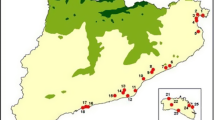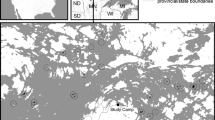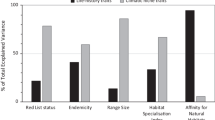Abstract
Ecological and historical factors virtually create a unique faunal assemblage on each island. From this perspective every island deserves protection. However, economic limitations usually restrict conservation efforts to particularly important areas. As part of the SLOSS issue (the relative importance of single large or several small areas), there is the long debated question of whether it is better to protect few large areas (islands) or several small areas (islands). Here, we assess the butterfly faunas of the Italian offshore islands, using several biodiversity measures, in order to highlight priorities for conserving butterfly richness, rarity and endemicity. First, the nested pattern of butterfly fauna was investigated to determine the relative importance of large and small islands. Then, residuals were assessed for the species-area relationship and for multiple regressions of richness, rarity and endemicity against geographic variables. Subsequently, two other indices were calculated: Biodiversity Conservation Concern and an index scoring islands in the order that maximizes the cumulative percentage of total, endemic, and rare species. The results clearly indicate that although greatest concern is for the island having the largest butterfly fauna in the sample (Elba), the importance of several small islands should not be ignored. This is primarily due to the substantial impact of source areas and consequently the occurrence of several rare and endemic species occurring on small islands as well as on large islands.






Similar content being viewed by others
References
Balletto E, Monelli S, Cassulo L (2005) Checklist e distribuzione della fauna italiana. 10.000 specie terrestri e delle acque interne: Insecta Lepidoptera Papilionoidea (Rhopalocera). Memorie del Museo civico di Storia Naturale di Verona 16:259–263+CD Rom
Beniston M, Stephenson DB, Christensen OB et al (2007) Future extreme events in European climate: an exploration of regional climate model projections. Clim Change 81(Suppl 1):71–95
Brock CS, Adsersen H (2007) Morphological variation among populations of Lecocarpus (Asteraceae) on the Galapagos Islands. Bot J Linn Soc 154:523–544
Brualdi RA, Sanderson JG (1999) Nested species subsets, gaps, and discrepancy. Oecologia 119:256–264
Dapporto L (2008) Geometric morphometrics reveal male genitalia differences in the Lasiommata megera/paramegaera complexes (Lepidoptera Nymphalidae) and the lack of a predicted hybridisation area in the Tuscan archipelago. J Zool Syst Evol Res, in press
Dapporto L, Cini A (2007) Faunal patterns in Tuscan archipelago butterflies: the dominant influence is recent geography not paleogeography. Eur J Entomol 104:497–503
Dapporto L, Dennis RLH (2008) Species’ richness, rarity and endemicity of Italian offshore islands: complementary signals from island-focused and species-focused analyses. J Biogeogr published online: doi:10.1111/j.1365.2699.2007.01812x
Dapporto L, Wolf H, Strumia F (2007) Recent geography determines the distribution of some flying Hymenoptera in the Tuscan Archipelago. J Zool 242:37–44
Debussche M, Lepart J, Dervieux A (1999) Mediterranean landscape changes: evidence from old postcards. Global Ecol Biogeogr 8:3–15
Dennis RLH, Shreeve TG (1996) Butterflies on British and Irish offshore islands: ecology and biogeography. Gem Publishing Company, Wallingford
Dennis RLH, Shreeve TG (1997) Diversity of butterfly species on British islands: ecological influences underlying the roles of area, isolation and faunal source. Biol J Linn Soc 60:257–275
Dennis RLH, Williams WR (1995) Implications of biogeographical structures for the conservation of European butterflies. In: Pullin AS (ed) Ecology and conservation of butterflies. Chapman and Hall, London, pp 213–229
Dennis RLH, Williams WR, Shreeve TG (1991) A multivariate approach to the determination of faunal units among European butterfly species (Lepidoptera: Papilionoidea, Hesperioidea). Zool J Linn Soc 101:1–49
Dennis RLH, Shreeve TG, Olivier A, Coutsis JG (2000) Contemporary geography dominates butterfly diversity gradients within the Aegean archipelago (Lepidoptera: Papilionoidea, Hesperioidea). J Biogeogr 27:1365–1384
Fattorini S (2006) A new method to identify important conservation areas applied to the butterflies of the Aegean islands (Greece). Anim Conserv 9:75–83
Fattorini S (2007) To fit or not to fit? A poorly fitting procedure produces inconsistent results when the species-area relationship is used to locate hotspots. Biodivers Conserv 16:2531–2538
Fischer J, Lindenmayer DB (2005) Perfectly nested or significantly nested – an important difference for conservation management. Oikos 109:485–494
Heaney LR (2007) Is a new paradigm emerging for oceanic island biogeography? J Biogeogr 34:753–757
Huntley B (1988) Europe. In: Huntley B, Webb T (eds) Vegetation history. Kluwer Academic Publishers, Dordrecht, pp 341–383
Lomolino MV (1994) An evaluation of alternative strategies for building networks of nature reserves. Biol Conserv 69:243–249
Lomolino MV (2000) A species-based theory of insular zoogeography. Global Ecol Biogeogr 9:39–58
MacArthur RH, Wilson EO (1967) The theory of island biogeography. Princeton University Press, Princeton
Mittermeier RA, Myers N, Gil PR et al (1999) Hotspots: earth’s biologically richest and most endangered terrestrial ecoregions. CEMEX, Conservation International and Agrupacion Sierra Madre, Mexico
Nee S, Colegrave N, West SA et al (2005) The illusion of invariant quantities in life histories. Science 309:1236–1239
New TR (2007) Understanding the requirements of the insects we seek to conserve. J Insect Conserv 11:95–97
Patterson BD, Atmar W (1986) Nested subsets and the structure of insular mammalian faunas and archipelagos. In: Heaney LR, Patterson BD (eds) Island biogeography of mammals. Academic Press, London
Penuelas J, Filella I, Comas P (2002) Changed plant and animal life cycles from 1952 to 2000 in the Mediterranean region. Glob Change Biol 8:531–544
Pimm SL, Lawton JH (1998) Planning for biodiversity. Science 279:2068–2069
Rosenzweig ML (2004) Applying species-area relationships to the conservation of species diversity. In: Lomolino MV, Heaney LR (eds) Frontiers of biogeography, new directions in the geography of nature. Sinauer Associates, Sunderland
Ryan PG, Bloomer P, Moloney CL et al (2007) Ecological speciation in South Atlantic island finches. Science 315:1420–1423
Samways M, Ponel P, Andrieu-Ponel V (2006) Palaeobiodiversity emphasizes the importance of conserving landscape heterogeneity and connectivity. J Insect Conserv 10:215–218
Schmitt T (2007) Molecular biogeography of Europe: Pleistocene cycles and Postglacial trends. Front Zool 4:11
Sforzi A, Bartolozzi L (2001) Libro Rosso degli insetti della Toscana. ARSIA Regione Toscana, Firenze
Simberloff D (1974) Equilibrium theory of island biogeography and ecology. Annu Rev Ecol Syst 5:161–182
Swengel AB, Swengel SR (2007) Benefit of permanent non-fire refugia for Lepidoptera conservation in fire-managed sites. J Insect Conserv 11:263–279
Thomas JA (2005) Monitoring change in the abundance and distribution of insects using butterflies and other indicator groups. Phil Trans R Soc B 360:339–357
Ulrich W, Buszko J (2005) Detecting biodiversity hotspots using species-area and endemics-area relationships: the case of butterflies. Biodivers Conserv 14:1977–1988
Ulrich W (2006) Nestedness – a FORTRAN program for calculating ecological matrix temperatures. www.uni.torun.pl/∼ulrichw
Ulrich W, Gotelli NJ (2007) Null model analysis of species nestedness patterns. Ecology 88:1824–1831
van Swaay CAM, Warren MS (1999) Red data book of European butterflies (Rhopalocera), nature and environment. Council of European Publishing, Strasbourg
Volpe G, Palmieri R (2006) Le farfalle diurn dell’Isola di Vivara. Associazione Naturalistica Arion, Napoli
Whittaker RJ (1998) Island biogeography: ecology, evolution, and conservation. Oxford University Press, Oxford
Williamson MH (1981) Island populations. Oxford University Press, Oxford
Wilson EO, Willis EO (1975) Applied biogeography. In: Cody ML, Diamond JM (eds) Ecology and evolution of communities. Harvard University Press, Cambridge
Acknowledgements
This study was conducted in collaboration with the Tuscan archipelago National Park. We also wish to thank the director and personnel of Gorgona prison for allowing us to study butterflies on the island, and the “Stazione Forestale di Follonica” for making it possible to study butterflies on Montecristo and Paolo Parenzan, Paul Sammut and Franco Strumia for helping in compiling a comprehensive butterfly database. We thank referees for their helpful comments.
Author information
Authors and Affiliations
Corresponding author
Rights and permissions
About this article
Cite this article
Dapporto, L., Dennis, R.L.H. Island size is not the only consideration. Ranking priorities for the conservation of butterflies on Italian offshore islands. J Insect Conserv 12, 237–249 (2008). https://doi.org/10.1007/s10841-008-9150-9
Received:
Accepted:
Published:
Issue Date:
DOI: https://doi.org/10.1007/s10841-008-9150-9




